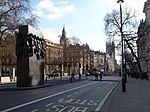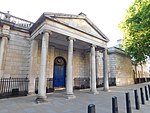Execution of Charles I

The execution of Charles I by beheading occurred on Tuesday 30 January 1649 outside the Banqueting House on Whitehall. The execution was the culmination of political and military conflicts between the royalists and the parliamentarians in England during the English Civil War, leading to the capture and trial of Charles I. On Saturday 27 January 1649, the parliamentarian High Court of Justice had declared Charles guilty of attempting to "uphold in himself an unlimited and tyrannical power to rule according to his will, and to overthrow the rights and liberties of the people" and he was sentenced to death.Charles spent his last few days in St James's Palace, accompanied by his most loyal subjects and visited by his family. On 30 January, he was taken to a large black scaffold constructed in front of the Banqueting House, where he was to be executed. A large crowd had gathered to witness the regicide. Charles stepped onto the scaffold and gave his last speech, declaring his innocence of the crimes of which parliament had accused him, and claiming himself as a "martyr of the people". The crowd could not hear the speech, owing to the many parliamentarian guards blocking the scaffold, but Charles' companion, Bishop William Juxon, recorded it in shorthand. Charles gave a few last words to Juxon, claiming his "incorruptible crown" in Heaven, and put his head on the block. He waited a few moments and gave a signal; the anonymous executioner beheaded Charles in one clean blow and held Charles' head up to the crowd silently, dropping it into the swarm of soldiers soon after. The execution has been described as one of the most significant and controversial events in English history. Some view it as the martyrdom of an innocent man, with Restoration historian Edward Hyde describing "a year of reproach and infamy above all years which had passed before it; a year of the highest dissimulation and hypocrisy, of the deepest villainy and most bloody treasons that any nation was ever cursed with" and the Tory Isaac D'Israeli writing of Charles as "having received the axe with the same collectedness of thought and died with the majesty with which he had lived", dying a "civil and political" martyr to Britain. Still others view it as a vital step towards democracy in Britain, with the prosecutor of Charles I, John Cook, declaring that it "pronounced sentence not only against one tyrant but against tyranny itself" and Whig historian Samuel Rawson Gardiner, who wrote that "with Charles' death the main obstacle to the establishment of a constitutional system had been removed. [...] The monarchy, as Charles understood it, had disappeared forever".
Excerpt from the Wikipedia article Execution of Charles I (License: CC BY-SA 3.0, Authors, Images).Execution of Charles I
Whitehall, City of Westminster Covent Garden
Geographical coordinates (GPS) Address Nearby Places Show on map
Geographical coordinates (GPS)
| Latitude | Longitude |
|---|---|
| N 51.50453 ° | E -0.12619 ° |
Address
Royal United Services Institute for Defence Studies
Whitehall
SW1A 2ET City of Westminster, Covent Garden
England, United Kingdom
Open on Google Maps










